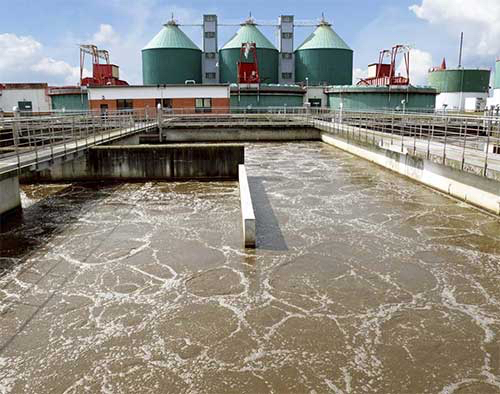Effluent / Waste Water

Zero Liquid Discharge Plant
Industrial waste water is one of the important pollutants in the pollution of the water environment. There are many types of industrial waste water based on different industries and contaminants; each sector produces its own particular combination of pollutants. The petrochemical industry discharges a lot of phenols and mineral oils. Also waste water from food processing plants is high in suspended solids and organic material. Generally, industrial wastewater can be divided into two types: inorganic industrial wastewater and organic industrial wastewater.
Inorganic Industrial Waste Water
Inorganic industrial waste water is produced mainly in the coal and steel industry, in the nonmetallic minerals industry, and in commercial enterprises and industries for the surface processing of metals (iron picking works and electroplating plants). This waste water contains a large proportion of suspended matter.
The purification of warm and dust-laden waste gases from blast furnaces, converts, cupola furnace, refuse and sludge incineration plants, and aluminum works result in waste water containing mineral and inorganic substances in dissolved and undissolved form.
In the separation of coal from dead rock, the normal means of transport and separation is water, which then contains large amounts of coal and rock particles and is called coal-washing water. Coal- washing water is recycled after removal of the coal and rock particles through floatation and sedimentation processes.
Other waste water from rolling mills contains mineral oil and requires additional installation, such as scum boards and skim-off apparatus, for the retention and removal of mineral oils. Residues of emulsified oil remaining in the water also need chemical flocculation.
Organic Industrial Waste water
Organic industrial waste water contains organic industrial waste flow from those chemical industries and large –scale chemical works, which mainly use organic substances for chemical reactions.
Most organic industrial waste water is produced by the following industries and plants:
The factories manufacturing pharmaceuticals, cosmetic, organic dye- stuffs, glue and adhesives, soaps, synthetic detergents, pesticides and herbicides:
The quality of the waste from the production of pharmaceuticals varies a great deal, owing to the variety of basic raw materials, working processes and waste products. It is a characteristic of the pharmaceutical industry that very many products as well as intermediate products are manufactured in the same plant. Thus different kinds of effluent with widely varying qualities flow from the different production areas.
For large chemical industries it is also usual to manufacture pharmaceutical products together with other chemical products. Sometimes waste substances include the extraction residues of natural and synthetic solvents, used nutrient solutions, specific poisonous substances and many other organics.
Tanneries and leather factories:
A tannery is one of the most water intensive plants and its production process consists of several steps. The quality of the water depends only to a slight degree on the type of hides and the mechanical and chemical methods used in tanning.
Textile factories:
The pollutant features of textile wastes differ widely among various organic substances such as dyes, starches and detergents in effluent undergo chemical and biological changes which consume dissolved oxygen from the receiving stream and destroy aquatic life.
Synthetic organic dyes, bleaches and detergents some chemicals are biodegradable? starch, however others such as dyes are non?biodegradable. Thus the effluents could have lower dissolved oxygen concentrations which means higher BOD and COD.
High concentrations of soluble inorganic salts may make the discharge water stream unsuitable for industrial and municipal use. Metals such as chromium and zinc are toxic to aquatic life and should be removed before discharge. Certain carrier chemicals used in dyeing, such as phenol may add bad taste and odor as well.
Cellulose and paper manufacturing plant:
Printing plants release inks and dyes, the pulp and paper rely heavily on chlorine- based substances, and as a result, pulp and paper mill effluents contain chloride organics and dioxins, as well as suspended solids and organic wastes.
Oil refining industries:
Petroleum wastewater from refineries contains high levels of pollutants and are characterized by the presence of large quantities of refinery effluent such as oil products and chemicals that are hard to degrade. Regulatory authorities deny permits to discharge this petroleum wastewater to maintain the chemical, physical and biological integrity of the fresh water resources.
Brewery and fermentation industries:
A part of the waste water produced by the brewery industries comes from the different processes, which includes the washing and rinsing water to clean the barley. All machine and filters and especially bottles and barrels. This type of waste water contains high concentration of suspended solids and detergents.
Metal processing industries:
The metal – working industries discharge chromium, nickel, zinc, cadmium, lead, iron and titanium compounds along them the electroplating industry is an important pollution distributor.

We at SVAAR provide Falling Film Evaporator, Rising Film Evaporator, Forced Circulation Evaporator, Agitated Thin Film Evaporator (ATFD) and or combination of above to treat various effluents to achieve ZERO LIQUID DISCHARGE compliance.
Our evaporation plant can recover almost 95% of the water in form of clear condensate from the effluent.